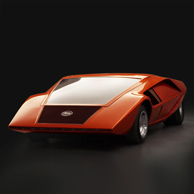Lancia Stratos Zero
concept car (1970)
The Lancia Stratos Zero is a concept car designed by Marcello Gandini in the late 1960s and built by Bertone in 1970. Presented at the Turin Motor Show in 1970.
The prototype called Zero, with bodywork by Bertone, uses a V4 engine from the Lancia Fulvia, recovered from a wrecker, placed in a central rear position.
The Lancia Stratos Zero is a Concept Car, like many others it never went into production, being above all a visionary instrument which, given its characteristics, could never have been approved for series production.
The prototype of the Lancia Stratos Zero designed by Marcello Gandini at Berone in 1970 is visionary and futuristic for many technical and aesthetic solutions.
The car was built for display at the Geneva Motor Show.
In order not to constrain the designer's design choices in defining the lines of the bodywork, all the mechanical parts are placed in a lowered position. Bertone, with this arrangement, created a prototype with an exaggerated wedge-shaped line, only 840 mm high, for a length of 3580 mm.
It is said that Nuccio Bertone, presenting the car to Lancia, had it pass under the entrance barrier of the old Turin factory. Marcello Gandini's goal was to "create an object that would attract the attention of visitors and above all of professionals. The important thing was to "get people talking about it".
His style, its extreme and futuristic lines have become iconic and are an inspiration for the cars of the future.
Lancia Stratos Zero is a special model due to its incredibly futuristic design, even in relation to recent standards. Inspired by the particular wedge-shaped line of the 1968 Carabo designed by Marcello Gandini, the concept presents one of the first examples of a horizontal light signature seen in the automotive world.
The presence of wheels constitutes the only conceptual reference to the idea of a car. The lateral contours exaggerate the wedge-shaped line, and the triangular shape of the air vents on the roof accentuate the visual gap compared to the classic stylistic features of the car.
The rear bonnet is hinged on the side and has the shape of an arrow, while the rear lights are formed by the simple luminous outline of the tail mirror, while the front ones are made up of 10 headlights placed side by side on the sharp nose of the car, painted in metallic bronze.
Looking at it better, you discover the side windows that are practically flush with the ground, while all the instruments are collected in a vertical panel to the left of the driver.












